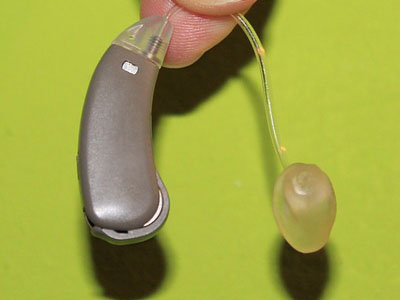Hearing & Hearing Loss

Hearing is one of the five senses, its prominence second only to eyesight. It is a complex process of picking up sound waves, transmitting to the brain and identifying the communication. Hearing ability is critical to understand the world around us.
Ear can be divided into three parts– the outer ear, middle ear and the inner ear leading to the brain.
- The outer ear consists of the ear canal and eardrum. Sound travels down the ear canal, strikes the eardrum and causes vibration or movements to the inner ear fluid.
- The middle ear is the space behind eardrum that contains three small bones called ossicles. This chain of tiny bones is connected to the eardrum at one end and to an opening to the inner ear at the other. Vibrations from the eardrum cause the ossicles to vibrate which, in turn, creates movement of the fluid in the inner ear.
- Movement of the fluid in the inner ear, or cochlea, causes changes in tiny structures called hair cells. This movement of the hair cells sends electric signals from the inner ear up the auditory nerve (also known as the hearing nerve) to the brain.
- The brain then interprets these electrical signals as sound.
HEARING LOSS
HEARING LOSS is a condition where the ability to detect certain sounds are completely or partially impaired.
Hearing loss can be categorised based on the damage to the parts of the auditory system. There are three basic types of hearing loss:
- Conductive hearing loss occurs when sound is not conducted efficiently through the outer ear canal to the eardrum and the tiny bones (ossicles) of the middle ear. Conductive hearing loss usually involves a reduction in sound level or the ability to hear faint sounds. This type of hearing loss can often be corrected medically or surgically.
- Sensorineural hearing loss (SNHL) occurs when there is damage to the inner ear (cochlea), or to the nerve pathways from the inner ear to the brain. Most of the time, SNHL cannot be medically or surgically corrected. This is the most common type of permanent hearing loss.
- Mixed hearing loss: Sometimes a conductive hearing loss occurs in combination with a sensorineural hearing loss (SNHL). In other words, there may be damage in the outer or middle ear and in the inner ear (cochlea) or auditory nerve. When this occurs, the hearing loss is referred to as a mixed hearing loss.
Ways to recognise hearing loss
- Do you have a problem hearing over the telephone?
- Do you have trouble following the conversation when two or more people are talking at the same time?
- Do people complain that you turn the TV volume up too high?
- Do you have to strain to understand conversation?
Do you ask others to repeat a lot?
- Do you have trouble hearing in a noisy background?
- Do you misunderstand what others are saying and respond inappropriately?
- Do you have trouble understanding the speech of women and children?
- Do people get annoyed because you misunderstand what they say?
If you answered "yes" to three or more of these questions, you may want to see an otolaryngologist (an ear, nose, and throat specialist) or an audiologist for a hearing evaluation.



